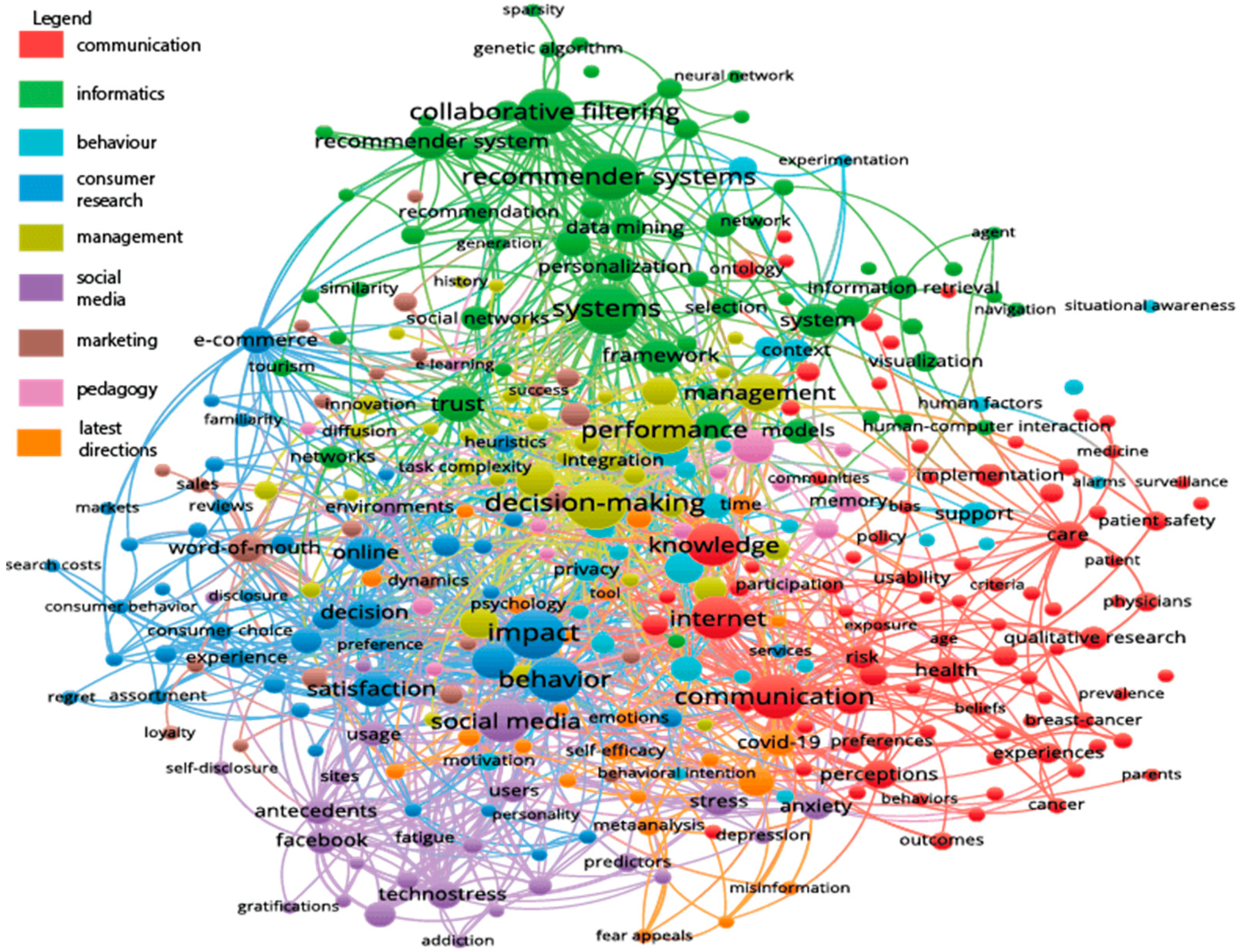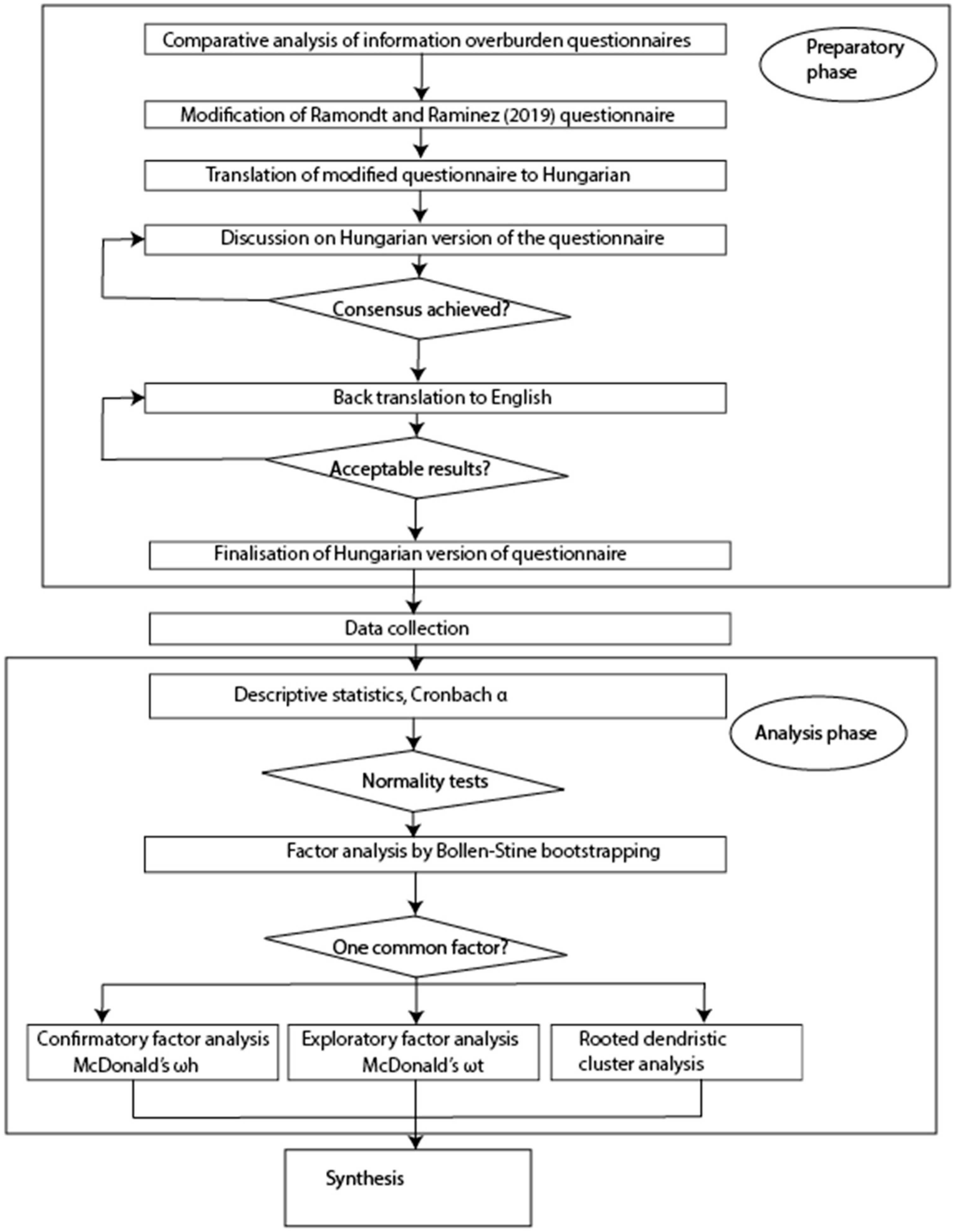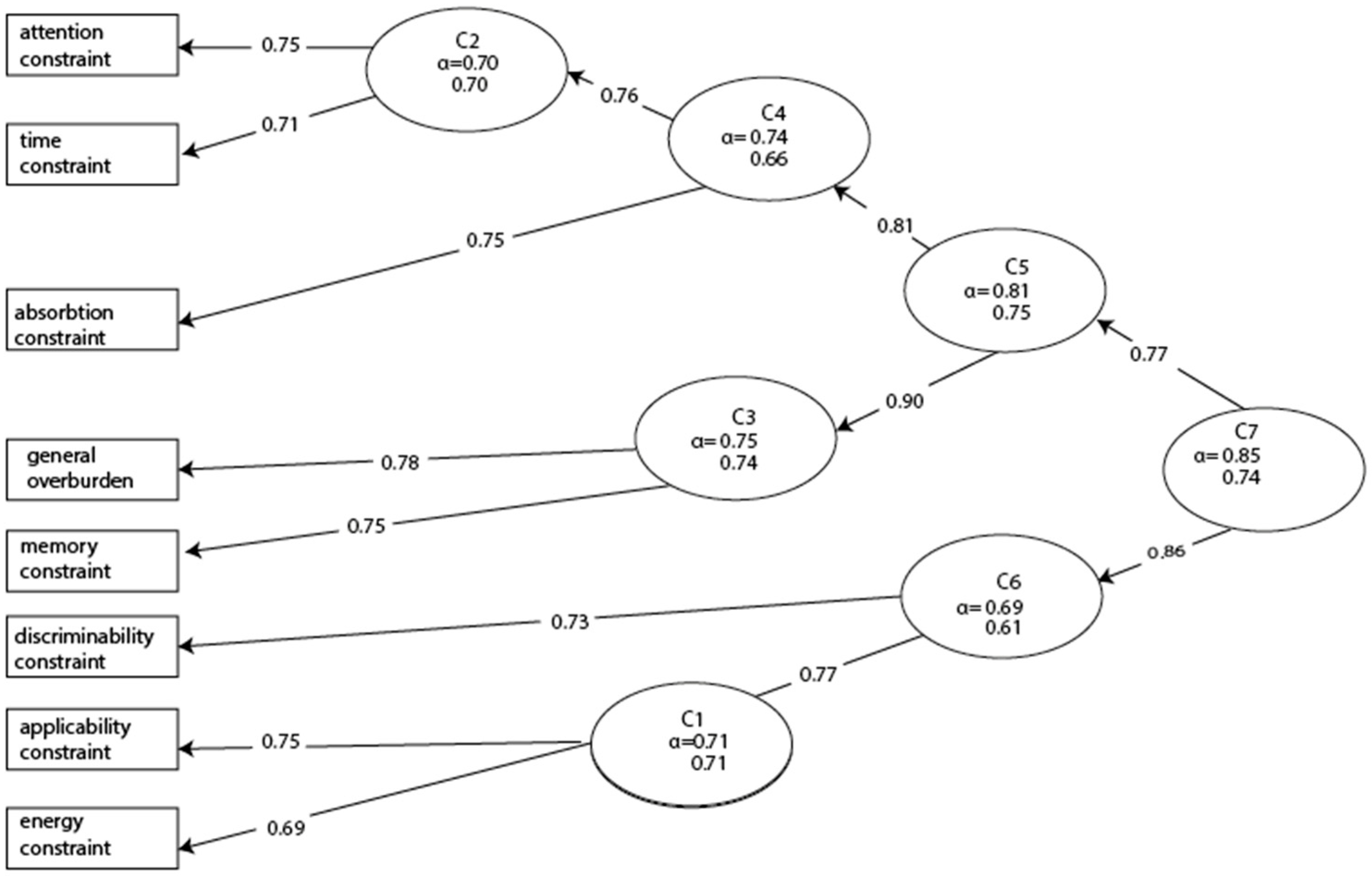1. Introduction
Western philosophy has been based on the paradigm that “information is good in virtue of being information” [
1]. It has been proven that an informed citizen makes better choices [
2]. The practical importance of academic and rigorous analysis of the information process is constantly growing because (1) the abundance of information and the relative ease of its accessibility radically increase and change societies [
3] and (2) there is increasing noise in communication channels, due to manipulations [
4].
There is increasing attention on information overload. By analyzing the Web of Science database, as one of the most comprehensive, high-quality, leading sources of academic publications [
5], we conducted the analysis based on the following search term:
(TS = (“information overload*” AND (“cons*” OR “decision*” OR “psy*”))) AND LANGUAGE: (English).
We have found 1426 articles, published in the English language in the time period of 1975–2021, on this topic. These articles were analyzed by the Vos viewer system, based on the clustering of keywords co-occurrence. The cluster analysis of the co-occurrence of keywords yielded nine clusters, which can be interpreted as the main directions of the research. These are summarized and visualized in
Figure 1.
There are three overarching topics, around which numerous research problems are clustered: the communication, informatics, and behavior science aspects of the information overload field. Interestingly, the communication-focused cluster embraces health-related aspects too, but nutrition-related communication does not appear in this cluster as an independent node, as opposed to the cancer-related one. Five applied fields of information overload appear in different clusters: consumer research, management science, social media, marketing, and pedagogy-related fields. One cluster has a relatively heterogeneous character, from COVID-19-related problems to meta-analysis of former communications. This cluster of topics embraces the latest directions of research.
Information overload research is a key, rapidly developing, highly diverse topic, one of the key aspects of which is health-related communication and its efficiency. This can be explained by the fact that the information process plays a key role in the context of health. Non-communicable diseases (NCDs) such as obesity, cardiovascular diseases, cancer, and diabetes are responsible for 70% of total deaths worldwide [
6]. To decrease the burden of NCDs, communication campaigns about healthy nutrition and diet could be useful as a method for public interventions [
7]. Since nutrition and diet are popular topics, new information about food products or dietary advice often appears in the news and on social media platforms. Exposure to an overwhelming amount of information from the environment full of contradictory facts about health and nutrition can lead to information overload. According to the information overload model, due to the excessive amount of content in the information environment, further cognitive resources are needed to process it. Thus, someone overwhelmed with information will intentionally avoid it. Information overload may cause people to be uncertain and prone to create beliefs about nutrition that negatively affect their preventive behavior [
8]. Jensen and co-workers have developed and validated the cancer information overload scale (CIO) to understand and relieve information overload [
9]. The CIO has been used by several researchers, in which the association between information environment and health behavior was supported. In their work, they have described that exposure to the information environment predicts information overload and negatively correlates with preventive behavior. To understand the negative effect of exposure to the information environment, Ramondt and Ramírez (2019) extended the concept of information overload to the association of nutritional and dietary information environment that could also be described as loaded with false information and contradictory advice [
10]. As a result, they have created the validated diet information overload (DIO) scale.
Athletes can be considered as a vulnerable group of consumers because sport demands an ever-increasing allocation of time and energy [
11,
12]. Athletes are at the center of the flow of nutrition information [
13], but it is an open-ended question as to how they can process these pieces of knowledge. Previously, numerous analyses have been carried out on some general characteristics or particular aspects of nutritional knowledge or education of athletes [
14,
15], but we do not have a holistic, general overview on the absorption of nutrition information by athletes. The extension of the concept of information overload to the information environment related to sport nutrition—which is also loaded with contradictory statements—has not been studied yet.
The objective of this study was to adapt and validate the diet information overload scale to measure sport nutrition information overload among athletes.
2. Materials and Methods
2.1. Study Population
Data analyzed in this study were obtained from a cross-sectional survey carried out between 2020 and 2021. The target group consisted of elite and recreational athletes; the inclusion criteria were at least 60 min of physical activity 3 times a week and age above 18 years. Originally, we planned to extend our survey to both recreational and elite athletes, but for the sake of a more homogenous group of athletes, we only included elite athletes in our analyses. We considered as elite athletes those who are licensed at a sports club, take part in at least regional-level competitions, and have at least two years’ experience of playing sport. The recruitment of participants was realized by the “snowball method”, based on different social media platforms (first of all, Facebook), and responses were collected by online Google forms. Considering restrictions due to COVID-19, we created an online form of the questionnaire because there was no possibility of filling it out in person. In the introductory part of the questionnaire, we informed the participants of the purpose and scope of the survey, the administration of the questionnaires, and the data. Participants gave their written informed consent following the Declaration of Helsinki and the Science Ethics Code of The Hungarian Academy of Sciences. The ethical approval to conduct the study was granted by the Institutional Ethics Committee of Department Science Policy and Scientometrics, Library and Information Centre of the Hungarian Academy of Sciences (Project identification number: 12733/1, date of approval: 1 February 2021).
The sample size calculation was based on the recommendation of Everitt [
16]. According to the “rule of thumb” (
n:
p) rule, the ratio between the number of subjects (
n) and the number of items of the questionnaire (
p) should be 10. Since the questionnaire is composed of 8 items, it was necessary to enroll at least 80 participants in the study.
2.2. Validation Methodology
The questionnaire used in this cross-sectional survey included questions about sociodemographic characteristics and sport activity besides the sport nutrition information overload scale.
We used the usually applied and accepted international methodology for the validation of questionnaires. As the first step, we translated the DIO scale from English to Hungarian with the help of a certified medical translator; then, we translated the Hungarian version back to the English language. For the next step, we asked Hungarian Ph.D. students using English as their working language to interpret the questions of the scale. We selected those terms that were difficult to translate to Hungarian, then the research team re-evaluated and modified the original translations. In the next step, we re-translated the Hungarian version of the questionnaire to English and asked three foreign Ph.D. students, who obtained their MSc/MA qualification in English language programs and now participate in the international Ph.D. program of the Hungarian University of Agriculture and Applied Life Sciences, to interpret the re-translated questions. As a result, we created a trial questionnaire and asked Ph.D. students to fill it out. Thus, we developed a final version that included no details that could lead to misunderstanding.
2.3. The Questionnaire
The sport nutrition information overload questionnaire applied in our current work has been developed in an evolving way. The measurement of information overload has considerable traditions: Jensen et al. (2011) created and validated the CIO scale, based on research on cancer-related information overload [
9]. Costa et al. (2014) shortened the original scale: in their opinion, 3 elements out of 8 can be discarded because these items do not question the amount of information, so the term of information overload cannot exactly be described by them [
17]. Some years later, Ramondt and Raminez (2019) modified the original questionnaire by Jensen to measure information overload on nutrition [
10]. Based on these predecessors, we constructed a sport nutrition information overload questionnaire. This is a novel version of the questionnaire because it focuses on sport nutrition overload, and not on nutrition-related information overload in general. Following the adaptation methodology of Ramondt and Ramírez [
10], the adaptation involved changing “diet” or “diet prevention” phrases to “sport nutrition” or “eating for sports”. The scale consists of eight items, measuring the perceived importance of different constraints of application of pieces of information on Likert-type scales.
Table 1 shows the items from the scale for cancer patients, the diet information overload scale adapted for healthy adults, and the items adapted for athletes by our research team.
2.4. Statistical Analysis
A multistep, one- and multivariable analysis of data was carried out, consisting of a step-by-step process, in line with the latest results of the validation process. In the first phase of investigations, we determined the descriptive characteristics of the responses to different items. Then, we tested the normality of individual responses by the Lilliefors (Kolmogorov–Smirnov) and the Shapiro–Wilk tests. As the first step of validation, we determined the Cronbach α value, as a standard, widely used indicator of item validity. In the next phase, we analyzed the reliability of the scales, if the items are dropped out, one by one. The reliability of the scales has been measured based on Cronbach’s α and Guttman’s λ6. Both reliability indices were calculated based on covariances (“raw” reliabilities) and correlations (standardizes reliabilities). In the last phase of the investigations, a unidimensionality test was fulfilled by confirmatory factor analysis, and based on confirmatory factor analysis, we were able to determine a model.
An alternative possibility of general factor saturation is the omega hierarchical test (ωh) proposed by Roderick P. McDonald [
18]. We applied a rather complex method, taking into consideration the specific features of the sample. First, we made a factor analysis of the original dataset, then rotated the factors. We applied the oblique rotation method because this is more suitable to study problems in social sciences than the generally applied varimax algorithm. After all, in the case of an oblique solution, we allow correlation between the factors and do not suppose orthogonality [
19]. In the next phase, based on Schmid–Leiman transformation [
20], we rotated the factors, and in this way, a general, second-level factor could be determined from the primary factor structure. In this phase, we applied the built-in algorithms of the psych r-package [
21]. According to Zinbarg et al. (2006), McDonald’s omega is better to estimate reliability than Cronbach’s α [
22]. At the end of the analysis, results were cross-validated by hierarchical cluster analysis. The key steps of the questionnaire’s development, data collection and statistical analysis are summarized in
Figure 2.
4. Discussion
The information overload scale was adapted from the context of cancer patients and then it was validated to measure the perception of the information environment related to healthy eating [
10]. Our study aimed to evaluate the applicability of the diet information overload scale and validate it among athletes. The original cancer-related information overload by Jensen et al. (2011) consists of eight items. Costa et al. (2014) shortened the original scale to a five-item scale [
9,
17]. Ramondt and Ramírez (2019) validated the original eight-item scale, but they recommended using the shortened version of the scale [
10]. Our results highlight that all eight items of the scale are relevant based on traditional indicators of reliability; the original eight-item scale is suitable and reliable for the measurement of sport nutrition information overload.
By analyzing the results of the survey, it can be stated that sport nutrition information overload is a general problem among athletes. Athletes face a high quantity of sport nutrition information and feel like they have a relatively limited time to process it. Feeling overloaded by the amount of information about sport nutrition and remembering it have been perceived as stronger barriers in the case of men than in the case of women. A possible explanation for this can be the relatively lower level of interest of men in sport nutrition-related information. The lower interest in sport nutrition information could be associated with lower knowledge and misconceptions about sports nutrition [
26].
On the contrary to the research results of Ramondt and Ramírez, our results highlight that sport nutrition information overload does not depend on the level of qualification. Athletes with lower and higher education both face this problem. This fact highlights the importance of understanding the intensity of sport nutrition information overload and the information flow of different social media platforms.
The “classic” indicators of reliability have given acceptable results. Taber (2018) analyzed the use and evaluation of Cronbach’s α when reporting different scales on the basis of 69 different papers [
27]. He concluded that a Cronbach α of 0.81 has been evaluated as “high”, “good”, “adequate” or “reasonable” based on the opinion of the authors. If we take the results of the simulation, we can conclude that as the α is higher than 0.71, the high reliability and applicability of the scale are supported. The different fit indices have shown the relatively good fit of the model; the RMSEA value was clustered to the generally applied 0.08 cutoff value, and the TLI value was near 0.9, which is generally considered as an indicator of acceptable fit [
28].
The socioeconomic structure of the sample is distorted because the higher qualified, urban part of the Hungarian athletes is over-represented, but this fact cannot be considered as a disqualifying limitation because our goal has been to test a questionnaire based on the absorption of sport nutrition-related pieces of information. Arguably, a more qualified part of the population is more suitable to supply adequate, coherent responses than such athletes to whom the decoding of simple, everyday communication would be a challenge.
The novelty of the current article is twofold: (1) we validate a tool for measurement of sport nutrition information overload in the case of athletes and examine athletes’ perceptions of the sport nutrition information environment; (2) we apply a combination of different sophisticated, cutting-edge validation methods, going beyond the traditional item reliability indicators (e.g., Cronbach α).
The limitation of the current validation study is that some participants may have been reluctant to report that they are not capable of keeping abreast with the flow of nutrition-related pieces of information. Theoretically, this could be a characteristic phenomenon in cases of such respondents whose profession is related to health, food, or nutrition.











